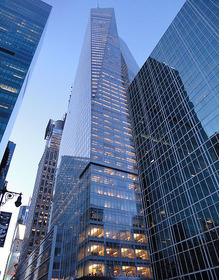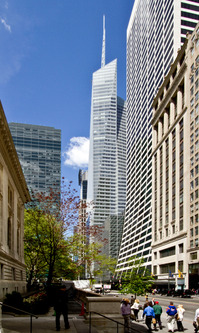The WPJ
THE WORLD PROPERTY JOURNALReal Estate Facts Not Fiction
Featured Columnists

Is New York's Greenest Building Really Green?
Commercial News » Global Property Beat | By Kevin Brass | August 5, 2013 7:30 AM ET
An article in the New Republic is refocusing attention on one of the dirty little secrets of the mania to build tall buildings.
The Bank of America Tower in New York building, once touted as New York's greenest building, is "actually its biggest energy hog," New Republic author Sam Roudman wrote. The 55-story tower, completed in 2010, was equipped with waterless urinals, daylight dimming controls, rainwater harvesting systems and an array of other green technologies, earning it the first-ever LEED platinum rating for a skyscraper. Even Al Gore praised it.
But once it opened, the building's performance was much different than the hype. In reality, the building consumes twice as much energy per square foot as the retrofitted Empire State Building, according to a city study. Even compared to projects with much lower LEEDs ratings, the building billed as "the most sustainable in the country" is a huge energy guzzler.
This won't be a big surprise to anyone in the building world. Despite all the rhetoric about sustainability and technological advances, skyscrapers are rarely very green, even those buildings relentlessly promoted as green.
For the environmental community, this debate is not idle chit-chat. Buildings are the world's biggest energy consumers and they emit huge amounts of greenhouse gases, with flashy skyscrapers among the biggest abusers.
On one level, the wildly read New Republic report is an indictment of the LEED certification system, which is nothing new. The Leadership in Energy and Environmental Design (LEED), program administered by the nonprofit U.S. Green Building Council, rewards designers for following certain set guidelines, but displays little interest in the actual performance of the building once it is finished.
 "The plaque [for LEED certification] should be installed with removable screws," energy consultant Henry Gifford told the New York Times in 2009. "Once the plaque is glued on, there's no incentive to do better."
"The plaque [for LEED certification] should be installed with removable screws," energy consultant Henry Gifford told the New York Times in 2009. "Once the plaque is glued on, there's no incentive to do better."Last year, USA Today detailed how the Palazzo Hotel and Casino in Las Vegas, a 50-story complex with decorative fountains and power-controlled curtains, managed to earn a LEED green certification. Sure, the smoke-filled casino and free-spending hotel guests gulp energy, but the design did include bike racks, room cards telling guests when towels are replaced and grass-less landscaping - even though few people ride bikes or grow grass in the desert. Nevertheless, the LEED rating earned the Palazzo developers a $27 million tax break
Following the LEED system doesn't necessarily lead to a better environmental building, developers know. Last year, Douglas Durst, who built the Bank of America tower, said he wouldn't be following LEED guidelines for a Bjarke Ingels-designed residential project in New York, which he hoped to make more environmentally innovative than the standards set for LEED.
"We found [LEED] to be a little confining," Mr. Durst, chairman of the Durst Organization, told the Wall Street Journal. "There are things we want to do that don't give us a benefit under LEED."
 But the LEED rating is only part of the issue for the Bank of America tower, which was launched with so much fanfare. There is much larger debate raging within the design and building community about the role of tall buildings in cities around the world.
But the LEED rating is only part of the issue for the Bank of America tower, which was launched with so much fanfare. There is much larger debate raging within the design and building community about the role of tall buildings in cities around the world.After a certain height, most skyscrapers are about ego and marketing more than efficiency and sustainability. Even economically, skyscrapers taller than 40 stories rarely make sense. An iconic building may add value to the surrounding land - now known as the "Burj Khalifa Effect" - but that doesn't make a kilometer-tall building any more logical.
Yet, to many urban planners, tall buildings are the key to future cities. Skyscrapers offer real value in terms of land use and creating efficient, dense neighborhoods. True vertical cities with services, green areas and entertainment all within a tightly compact area can change the way cities operate and flourish.
But tall buildings alone aren't necessarily "green." Build a skyscraper out in the middle of nowhere and people still have to drive to it. If there are no schools, stores and hospitals nearby, even the most energy efficient skyscrapers will be nothing more than islands, contributors to a new form of vertical sprawl. No amount of high-tech waterless urinals will make that dramatic all-glass tower a truly green project.
The Bank of America experience shows how easy it is to undermine good intentions. There really is no mystery behind the building's energy usage. A third of the leasable space is filled by huge financial trading floors, packed with electricity-guzzling computers and monitors, not to mention the servers and the systems needed to cool the space and equipment.
No building, no matter how well designed, could be considered energy efficient with those kinds of tenants. The Bank of America building may have been designed to set new standards for environmental skyscrapers; instead it simply illustrates that a building is only as green and sustainable as the people in it.
Sign Up Free | The WPJ Weekly Newsletter
Relevant real estate news.
Actionable market intelligence.
Right to your inbox every week.
Real Estate Listings Showcase
Related News Stories
Featured Columnists Real Estate Headlines
- 2025 Prediction: U.S. Commercial Investment Recovery Expected to Gain Traction
- Holiday Retail Sales for 2024 to Hit Record $1 Trillion
- Tech, AI Industries Drive Largest Share of Office Leasing Activity in U.S.
- Commercial Real Estate Lending in U.S. Enjoys Strong Growth in Q3
- U.S. Multifamily Market Begins Recovery in Q3
- Commercial Investment in Japan Spikes 24 Percent Annually in Q3
- Despite Return-to-Office Mandates, U.S. Office Vacancies Continue to Rise
- PROPSIG Tech Startup Acquired by World Property Data
- U.S. Commercial Mortgage Debt Hits $4.7 Trillion in Q2 as Delinquencies Increase
- Hong Kong Class A Office Rents Continue to Downtick in Mid-Summer
- U.S. Office Landlords Tenant Concessions Decline for First Time in 4 Years
- U.S. Commercial Mortgage Originations Spike 27 Percent in Q2 Over Q1
- Phnom Penh's Commercial Office, Retail Markets Face Slowdowns in 2024
- Global Edge Data Center Market to Hit $300 Billion by 2026
- Commercial Property Transactions in Japan Dive 25 Percent Annually in Q2
- Delinquency Rates for U.S. Commercial Property Loans Downticks in Q2
- Megawarehouse Lease Deals in U.S. Increase in 2024
- Office Tenants' Flight to Quality Buildings Increases in 2024
- Commercial Lending in Japan Upticks 6 Percent Annually in Q1
- AI Driving Significant Global Data Center Growth in 2024
- Total U.S. Commercial Mortgage Debt Rises to $4.7 Trillion in Q1
- U.S. Commercial Mortgage Delinquencies Rise in Early 2024
- Asia Pacific Office Sector to Further Reprice Throughout 2024
- U.S. Retail Foot Traffic to Surpass Pre-Pandemic Levels by 2025
- Commercial Real Estate Lending in U.S. Slowed in First Quarter
- Japan Commercial Property Investment Volume Jumps 7 Percent in Q1
- Asia Pacific Commercial Property Investment Leads the World, Spikes 13 Percent
- Driven by High Rates, U.S. Commercial Lending Imploded 47 Percent in 2023
- After Two Year Slump, Prime Multifamily Metrics Uptick in U.S.
- Commercial Co-Broker Commissions Not Affected by NAR-DOJ Settlement, Yet
- U.S. Office Buildings with Upscale Tenant Amenities Still Enjoy Premium Rents in 2024
- U.S. Commercial, Multifamily Mortgage Delinquency Rates Uptick in Q4
- U.S. Commercial Mortgage Debt Continued to Rise in 2023, Hits $4.7 Trillion
- Nonresidential Construction Spending in the U.S. Falls Sharply in January
- U.S. Multifamily Construction Starts to Decline in 2024
- Commercial Mortgage Lending in U.S. Shows Signs of Stabilization in Late 2023
- Architecture Billings Decline in December as Soft Business Conditions Persist
- Government Sector Claimed Largest Portion of 100 Biggest U.S. Office Leases Signed in 2023
- U.S. Commercial, Multifamily Borrowing Dives 25 Percent Annually in Late 2023
- Record High Multifamily Construction Deliveries Drive Vacancy Rates Higher
Reader Poll
Marketplace Links
This website uses cookies to improve user experience. By using our website you consent in accordance with our Cookie Policy. Read More





